Managed kdb Insights
Amazon FinSpace with Managed kdb Insights provides a fully managed service for the latest version of kdb’s analytics engine. Kdb Insights is the leading time-series analytics engine used by capital markets customers to power their business-critical analytics workloads, such as liquidity insights, pricing, transaction cost analysis, and back-testing.
With Amazon FinSpace Managed kdb Insights, you can deploy your existing real-time stream processing and high-performance kdb code in the AWS cloud to power time-sensitive analytics workloads. This is fundamental to running investment and trading businesses.
Using Managed kdb Insights’ clusters, you can quickly set up a managed data processing and analytics hub. With a few clicks in the Managed kdb Insights application, you can migrate your existing kdb datasets to FinSpace. By configuring Managed kdb Insights to auto scale the kdb clusters up and down, you can meet the availability and runtime performance needs of each of your kdb workloads. You can configure your Managed kdb Insights clusters to automatically deploy across multiple Availability Zones and Regions to ensure that your analytics environment is available during the most critical business hours.
As a result, you no longer require teams of specialists to monitor the infrastructure. This is because Managed kdb Insights continuously monitors underlying server health and capacity, and automatically replaces servers when they fail and patches servers in need of updates. In addition, it simplifies the work required to set up and deploy new clusters so the kdb administrators can focus more on business needs. Managed kdb Insights also supports running the same customer-developed kdb scripts that they run today on premises, and provides the same familiar kdb interfaces.
How it works

The diagram describes key components of Managed kdb Insights:
-
You can manage Managed kdb Insights resources by using the AWS Management Console or the SDK/CLI.
-
Data is stored in durable object store back databases.
-
Compute clusters running kdb software access data in the database.
-
Data can be cached from the database on high performance disk cache for fast access by the cluster.
-
Developers and quantitative analysts (quants) can access clusters via kdb IPC connections.
-
Access can be controlled through IAM.
-
Activity is logged to CloudTrail and CloudWatch.